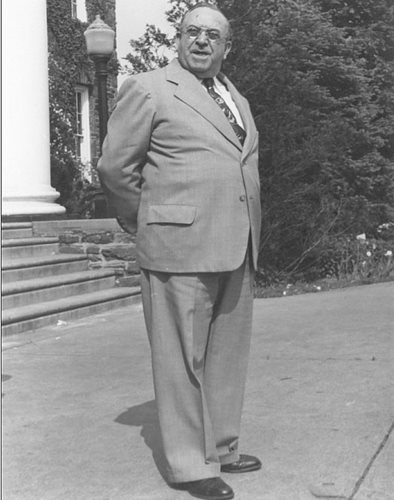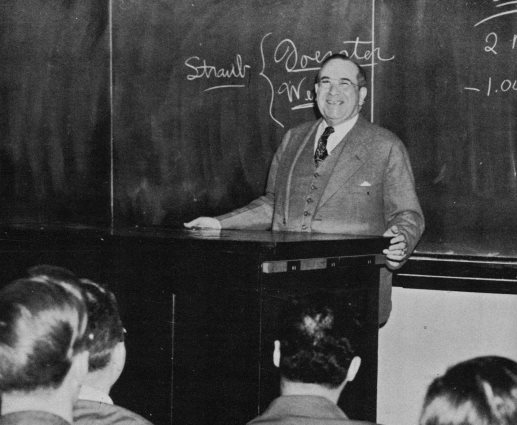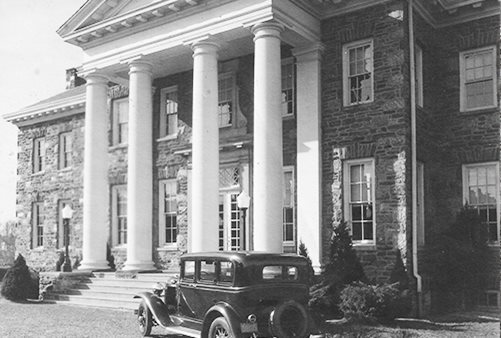The Optimist Optometrist: Dr. Albert Fitch and the Making of PCO (Part I)
 Those that think futuristically are often at risk for public ridicule - but with a lot of motivation and confidence in their dreams - they often succeed. A select few of those who succeed are lucky enough to be considered a visionary.
Those that think futuristically are often at risk for public ridicule - but with a lot of motivation and confidence in their dreams - they often succeed. A select few of those who succeed are lucky enough to be considered a visionary.
The founder of the Pennsylvania State College of Optometry (later named to Pennsylvania College of Optometry (PCO) in 1964) and first president from 1919 until his death in February of 1960, Dr. Albert Fitch was indeed a visionary. He led the fight for the recognition of optometric education and the establishment of optometry as a licensed profession. Almost single-handedly, he raised optometry to new professional levels by the high educational standards he established at the College. His belief that “a proper college of optometry must compete with any of the colleges of the other health professions, such as medicine and dentistry, and be on par with the best of them” was the hallmark of his outstanding leadership to the profession and to PCO. He established many firsts for both the College, as it was affectionately called, and the profession of optometry. Through Dr. Fitch’s leadership, the College was one of the first to be given permission to grant the Doctor of Optometry (OD) degree.
The Start
Despite his long-standing success in optometry, it was not Dr. Fitch’s initial career path. His first job as a school boy was in 1892 at the old Philadelphia Times newspaper where he worked as a newsboy selling papers early in the morning before school at a salary.
When he finished school, he went to work for Vincent McLaughlin, the manager of the Philadelphia Times. He worked there for nine years and was promoted to a reporter. When the ownership of the company changed, Fitch was again promoted to be the circulation manager of the paper, but was soon after demoted as staff positions at the paper changed and staff from the New York Times began taking over certain roles. It was then that Fitch resigned and had trouble securing another job at a newspaper.
After he was offered a job at an advertising company he met William Fairman, who was engaged in an optical business with a few other doctors who wished to advance their practice. While his offer at the advertising firm was decent, he decided to take a risk and jump careers, declined the advertising position and started in the optical business for just $9 per week. This was Dr. Fitch’s introduction to the world of optometry.
At a time when optometry was not well-regulated, Dr. Edward Gifford, a renowned ophthalmologist, saw Dr. Fitch’s potential, and took it upon himself to train him. Under Dr. Gifford’s supervision, Dr. Fitch was allowed to see his patients. Dr. Fitch took it upon himself to practice on friends and family and learned the pathology of diseases.
 Becoming a Doctor
Becoming a Doctor
In 1906, after four years of working with Dr. Gifford, Dr. Fitch opened his own practice in Philadelphia’s Kensington section. He was quite successful and by 1912, he had opened two additional practices.
In his autobiography, “My Fifty Years in Optometry,” published in 1955, Dr. Fitch wrote about adopting the “Doctor” title, as many medical doctors during that time took the title not from attending medical school, but from studying medicine under the supervision of a doctor.
As he opened his practices and gained additional experience and knowledge, he became more interested in organized optometry. He started to attend Philadelphia Optical Association meetings. “I soon found out that any suggestions from me were unacceptable as being radical or as being mere flights of fancy,” Dr. Fitch wrote. However, from time to time, his suggestions were adopted, but only after they had been introduced again by somebody else.
Much to his chagrin, he stopped attending the meetings until a friend told him that the next meeting was to be the final one prior to the optometrists vote to join with the medical board - a vote that would give the medical board jurisdiction in the issuance of optometric licenses. That piqued Dr. Fitch’s interest to come back. During the meeting, the majority of attendees felt it was right to give the medical board jurisdiction.
In a moment that undoubtedly changed his life forever, it was Dr. Fitch who opposed the Medical Board’s decision of classifying optometry as a “minor branch in medicine” in the 1913 Amendment to the Medical Act of 1911. He believed optometry needed to be recognized as a profession and deemed the amendment as unconstitutional. He continued to push for optometry to run independently from a medical doctor’s line of work and encouraged optometry to develop and grow without being managed by another profession. Dr. Fitch had accidentally fallen into legislature for the profession, something that he would fight for the rest of his life.
Bigger Dreams
Dr. Fitch didn’t stop with legislature. He dreamt of forming a society to offer professionals a place where they could study optometry in its entirety. He was a founding member of the Association of Schools and Colleges of Optometry (ASCO). The purpose of the association was to be the establishment of a non-profit College of Optometry. Today, the association continues to be the academic leadership organization committed to promoting, advancing, and achieving excellence in optometric education. At a bill signing, Dr. Fitch overheard discouraging words from the Pennsylvania Governor that he thought optometrists of the State of Pennsylvania would not raise their educational standards and provide educational institutions to carry out the high standards that Dr. Fitch and others were proposing. It was then that Dr. Fitch forged full-steam ahead in the establishment of the Pennsylvania State College of Optometry (PSCO) in 1919.
True to his persistent nature, Dr. Fitch took his committee to view properties to hold the College - although they insisted he didn’t have enough money to buy a property. He spotted properties on the 1800 block of Spring Garden Street - and bee-lined for them. While indeed he did not have enough money, he used his charms and asked the real estate agent to work with him - as long as he was able to successfully fundraise. In the end, Dr. Fitch purchased the building for $17,500 – a $4,000 reduction on the original price.
 The College first opened its doors on October 6, 1919. It was the largest freshman class to enroll in any school or college of optometry at that time. Thirty-three students enrolled in the three year night school course, tuition was set at $150 for the year, and there was a faculty of six. In the same year, 11 of the 33 students failed the examinations and were required to drop out.
The College first opened its doors on October 6, 1919. It was the largest freshman class to enroll in any school or college of optometry at that time. Thirty-three students enrolled in the three year night school course, tuition was set at $150 for the year, and there was a faculty of six. In the same year, 11 of the 33 students failed the examinations and were required to drop out.
What should have been an exciting time for the College was actually a time of upheaval. By the end of the second year, the administration started to fall apart and the College Association as well. Dr. Fitch found himself not only as president, but in the position of dean of the College - a combination he wasn’t fond of.
Pushing through these early troubles, the College held its first Commencement exercise in 1922. Every member of the first graduating class successfully passed the Pennsylvania Board of Examiners in Optometry.
Almost from the very opening, the institution and students conducted a clinic for the poor, wherein their eyes were cared for without cost to them and prescription glasses were dispensed. By 1925, one of Dr. Fitch’s proudest accomplishments was to acquire a clinical building, in close proximity to the main campus. It gave the College the opportunity to establish the first fully equipped optometric clinic in the country, complete with an ophthalmological department.
Patients were examined every afternoon in eleven refracting rooms and one ophthalmological treatment room. Clinical faculty included a director, two chiefs and eight unpaid assistant chiefs. Students in their final year completed all of the refracting and fitting under the direction of the faculty. Patient referrals came from social welfare agencies. Optical manufacturers and laboratories donated both lenses and frames and when a prescription was ordered; the glasses were fabricated on site by students and dispensed to the patient at no charge.
 Due to the College’s growth during its initial lucky 13 years, it moved to a large, 32-acre campus in the Oak Lane section of Philadelphia in 1932. The Spring Garden Street building was then used solely as a clinical facility.
Due to the College’s growth during its initial lucky 13 years, it moved to a large, 32-acre campus in the Oak Lane section of Philadelphia in 1932. The Spring Garden Street building was then used solely as a clinical facility.
The College became a staple in the advancement of optometry and its research, clinical care practices, and the exchange of ideas among professionals. As other optometry schools started to match PSCO’s entrance and graduation requirements, PSCO was again steps ahead. By 1935, the institution had increased the program length to four years - something that they were alone in doing so for many years and in 1941, the College was accredited by the Council on Optometric Education.
Just over 20 years after opening, PSCO grew substantially thanks to Dr. Fitch’s extraordinary vision and his determination.
Look for Part II in the next magazine.